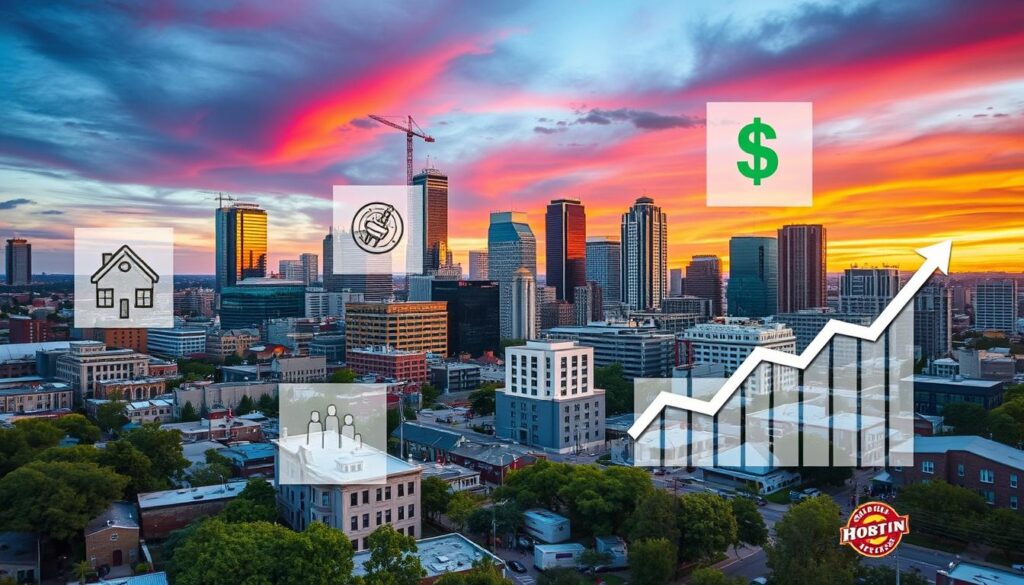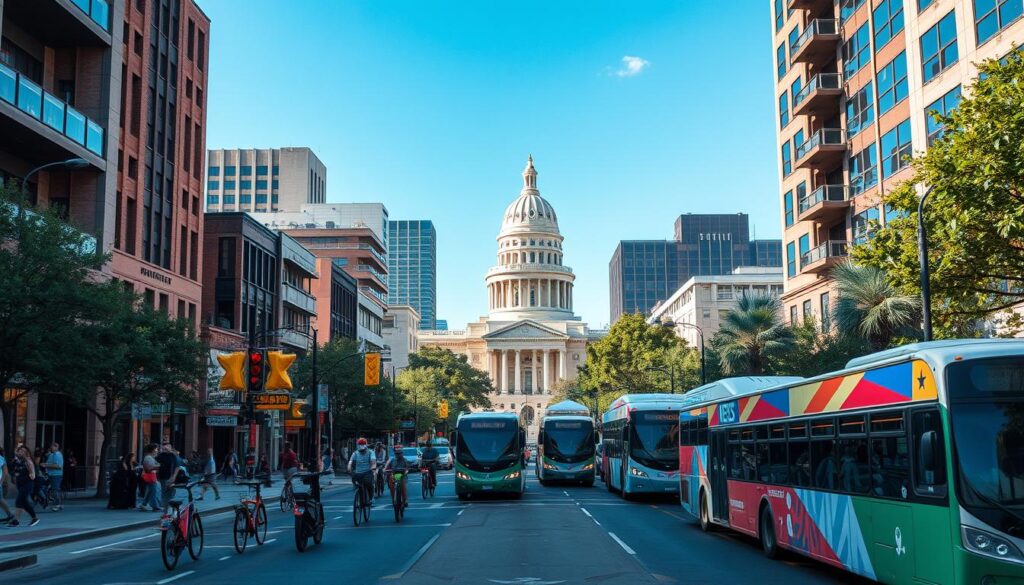Is Austin still worth moving to?
Get Your Free Moving Estimate
As we evaluate whether Austin remains a desirable location for relocation, it’s essential to consider its increasing appeal. With a thriving job market, vibrant culture, and myriad opportunities for both families and young professionals, the question on many minds is, “Is Austin still worth moving to?” At HeavenlyMove, our two decades of experience position us as experts in navigating these conversations. We’re here to explore what makes Austin an enticing living destination and address any inquiries you may have about moving to Austin.
Key Takeaways
- Austin offers a vibrant culture and growing job market.
- The city has seen an increase in family-oriented amenities.
- Over two decades of expertise backs our insights into moving services.
- Economic growth in Austin remains robust.
- Trustworthy insights on relocation decisions are essential.
Overview of Austin as a Living Destination
Austin has become a vibrant and attractive option for those looking to relocate. Its rich history and dynamic population contribute to a unique cultural atmosphere that appeals to many. The current landscape reflects a rapid transformation, marked by an influx of new residents seeking opportunities in a flourishing environment. By exploring the history of Austin, along with its current demographics, one can better appreciate what this city has to offer.
Brief History of Austin
The history of Austin dates back to its establishment in the early 1830s as a small settlement. Originally named “Waterloo,” the city was later renamed in honor of Stephen F. Austin, the “Father of Texas.” Throughout the years, Austin evolved into the capital of Texas, experiencing significant growth in the 20th century. Major developments in education, technology, and entertainment have shaped its identity as a bustling metropolitan area.
Current Demographics
Austin demographics reflect a diverse and youthful population. As of 2023, the city is witnessing a notable population increase, driven primarily by young professionals and families attracted to its thriving job market. Key demographic statistics include:
- Population: Approximately 1 million residents
- Age: A median age of 33 years
- Diversity: Over 40% of residents identify as part of a minority group
This overview of Austin sheds light on both its historical significance and current trends, illustrating why it remains a highly sought-after living destination.
Job Market and Economic Growth
The job market in Austin shows remarkable strength, driven by substantial economic growth. Various industries are thriving in this vibrant city, making it an attractive destination for professionals seeking new opportunities.
Booming Industries in Austin
Austin hosts a diverse range of booming industries. Key sectors contributing to the job market include:
- Technology
- Healthcare
- Education
- Renewable Energy
As a result, this thriving landscape provides a wealth of employment options for both seasoned experts and new graduates.
The Role of Tech Companies
Tech companies in Austin play a pivotal role in shaping the workforce. Industry giants such as Dell and Apple are at the forefront, attracting talent and stimulating innovation. These organizations continue to fuel economic growth, significantly impacting the local job market.
Unemployment Rates Compared
To understand the job market effectively, examining unemployment rates is crucial. Below is a comparison of Austin’s unemployment rates against national averages:
| Location | Unemployment Rate |
|---|---|
| Austin | 3.5% |
| National Average | 4.0% |
This data highlights Austin’s resilience in maintaining a lower unemployment rate, showcasing the city’s robust economic growth and strong job market.
Cost of Living in Austin
The cost of living in Austin has been a topic of considerable discussion, especially as the city continues to evolve. Understanding the current housing market trends, along with average rent prices in Austin, offers valuable insight for potential movers and residents alike. With a balance of affordability and demand, Austin’s real estate landscape reflects both local and national influences.
Housing Market Trends
Recent data indicates a dynamic shift in the housing market trends within Austin. Notably, increased demand for homes has led to a steady rise in property values. Factors contributing to this growth include:
- Strong job market attracting new residents
- Limited inventory of available homes
- Growing popularity of the city as a lifestyle destination
These elements combined have contributed to a competitive environment for buyers and renters, shaping the current state of housing.
Average Rent Prices
When examining rent prices in Austin, averages show significant variation by neighborhood. As of late 2023, the following monthly rental prices highlight this discrepancy:
| Neighborhood | Average Rent Price ($) |
|---|---|
| Downtown | 2,400 |
| South Austin | 1,900 |
| East Austin | 2,000 |
| North Austin | 1,700 |
Comparison with Other Major Cities
In comparison to cities like San Francisco and New York, the cost of living in Austin remains more accessible, particularly in terms of housing expense. By examining key aspects:
- Compared to San Francisco, housing costs are approximately 25% lower.
- Austin offers rent prices that are 15% lower than those in New York City.
- Austin’s property taxes are generally more favorable than many major cities.

Quality of Life Factors
The quality of life in Austin stands out due to its appealing climate, abundant outdoor activities, and vibrant arts and culture scene. These elements combine to create a desirable living environment for residents, making it an attractive choice for those thinking about relocation.
Climate and Weather Conditions
In assessing the quality of life in Austin, the climate in Austin plays a significant role. The city experiences a humid subtropical climate characterized by mild winters and hot summers. Average temperatures can reach the high 90s during summer, while winter sees milder conditions with average lows in the 40s. Such weather is ideal for year-round activities, ensuring that residents enjoy outdoor spaces without interruption.
Outdoor Activities and Parks
Austin’s commitment to outdoor activities in Austin is evident through its extensive parks and recreation facilities. Residents can engage in various activities, including hiking, biking, and kayaking. Major parks like Zilker Park and Barton Springs Pool serve as hubs for community events and provide access to nature. The city’s numerous trails cater to fitness enthusiasts and families alike, promoting a healthy and active lifestyle.
Arts and Culture Scene
The arts and culture scene greatly enhances the quality of life in Austin. Known as the “Live Music Capital of the World,” the city hosts numerous music festivals, including South by Southwest (SXSW) and Austin City Limits. Local theaters and galleries, along with a flourishing culinary scene, further enrich the community experience. This vibrant atmosphere fosters creativity and connection among its residents.
Education and Schools
Austin boasts a rich educational landscape, making it an attractive destination for families seeking quality schools and higher learning opportunities. The city’s public education in Austin serves a diverse community, providing multiple avenues for academic achievement, while private education options also add to the variety of choices for parents. This section explores the distinctions between public and private education, highlights prominent higher education institutions, and discusses the overall performance of schools.
Public vs. Private Education
The debate over public versus private education often hinges on various factors including curriculum, class sizes, and extracurricular activities. Public education in Austin offers a range of programs through school districts like Austin Independent School District (AISD), which is known for its emphasis on arts and inclusion. Private schools, such as St. Andrew’s Episcopal School and The Trinity School of Texas, provide alternative educational approaches, often with smaller class sizes and specialized programs.
Higher Education Institutions
Austin is home to several renowned higher education institutions, most notably the University of Texas at Austin. UT Austin offers a vast array of undergraduate and graduate programs, attracting students from across the country and beyond. The city also hosts Austin Community College, providing accessible education and training opportunities for those looking to enter the workforce or upgrade skills.
School Rankings and Performance
Many families consider school rankings and performance metrics when looking for schools in Austin. Local school district performance reports indicate that several schools consistently rank among the top in the state. U.S. News & World Report rankings highlight numerous schools excelling in academic performance, making them highly sought after by parents aiming to secure a quality education for their children.
Transportation and Connectivity
When considering moving to Austin, understanding the options for transportation is crucial for residents. Austin offers a variety of public transit alternatives that help navigate the city efficiently. We will explore the public transit in Austin, evaluate traffic conditions, and discuss the accessibility to neighboring cities.
Public Transit Options
Austin’s public transit system is primarily managed by Capital Metro, which includes bus services and the MetroRail. These options provide a reliable way to get around the city. Buses cover a comprehensive network throughout Austin, reaching many neighborhoods and commercial areas. The MetroRail extends from the northern suburbs to downtown, making it a convenient choice for commuters.
Traffic Conditions and Commute Times
Austin traffic conditions can be quite congested, especially during peak hours. It is not uncommon for residents to experience lengthy commute times. Understanding these conditions is essential for planning daily travel and managing schedules effectively. Common routes and their average commute times can significantly impact residential satisfaction and work-life balance.
Accessibility to Neighboring Cities
For those looking to travel beyond the city, Austin provides excellent connectivity to nearby cities such as San Antonio and Houston. Major highways facilitate quick access, making day trips or commutes to neighboring areas relatively straightforward. Understanding transit options for longer distances can aid newcomers in adjusting to life in Austin.

| Transit Option | Coverage | Average Commute Time |
|---|---|---|
| Capital Metro Bus | Citywide | 30-45 minutes |
| MetroRail | North to Downtown | 20-30 minutes |
| Major Highways | Regional Access | Varies |
Safety and Crime Rates
Austin is known for its vibrant culture and picturesque landscapes, but as with any urban area, understanding the safety in Austin is essential for residents and newcomers. Analyzing crime rates in Austin reveals significant trends that can influence daily life. Recent data shows fluctuations in various types of crime, prompting community safety initiatives to enhance security measures across neighborhoods.
Recent Crime Trends
The Austin Police Department’s statistics indicate a mixed bag of crime trends. While some categories such as property crime have seen a slight increase, violent crimes remain relatively stable. Understanding these fluctuations helps residents navigate their surroundings more confidently. Awareness of the types of crimes prevalent in specific areas will enhance their sense of security and allow them to make informed decisions.
Community Initiatives for Safety
Community safety initiatives play a critical role in fostering a secure environment. Organizations across Austin collaborate with local law enforcement to implement programs focused on crime prevention and community engagement. Initiatives such as neighborhood watch programs, community patrols, and safety workshops have been instrumental in creating a culture of vigilance and support among residents.
Resources for New Residents
For new residents, connecting with resources that promote safety in Austin can prove invaluable. A variety of platforms provide information on local safety reports, emergency contacts, and community resources. Local police departments often host meet-and-greet events, allowing residents to familiarize themselves with safety personnel and protocols. Keeping informed equips newcomers with confidence as they settle into their new homes.
| Crime Type | Current Rate | Comparison to Last Year |
|---|---|---|
| Violent Crime | 250 incidents | Stable |
| Property Crime | 1,200 incidents | +5% |
| Burglary | 400 incidents | -10% |
| Theft | 800 incidents | +8% |
Social Life and Nightlife
Austin is renowned for its vibrant social life and nightlife, making it a hub for those seeking entertainment and community engagement. The city’s diverse neighborhoods offer a range of experiences, from bustling areas filled with dining in Austin options to intimate venues featuring live performances. Let’s explore what sets Austin apart in this domain.
Popular Neighborhoods
Each neighborhood exudes its unique charm and atmosphere, contributing to the rich tapestry of nightlife in Austin. Notable areas include:
- Downtown Austin – Known for its lively streets lined with bars and clubs.
- The Domain – A blend of luxury dining in Austin and upscale nightlife offerings.
- South Congress (SoCo) – Famed for its eclectic shops and intimate music venues.
Dining and Culinary Scene
The dining in Austin scene reflects an impressive array of culinary styles, from food trucks serving innovative dishes to fine dining establishments that highlight local ingredients. Some favorites include:
- Franklin Barbecue – Renowned for mouth-watering brisket.
- Uchi – A sushi restaurant celebrated for its unique flavor combinations.
- La Condesa – Offers modern Mexican cuisine in a vibrant atmosphere.
Music and Entertainment Venues
Austin’s claim to being the “Live Music Capital of the World” is well-earned, with a plethora of venues showcasing local and national talent. Visit these iconic spots for unforgettable experiences:
- The Continental Club – A legendary venue featuring rock and blues.
- Stubbs Bar-B-Q – Known for live performances alongside delicious barbecue fare.
- ACL Live at The Moody Theater – Hosts the famous Austin City Limits series.
Diversity and Inclusivity
Austin stands as a vibrant example of diversity and inclusivity, a quality that many residents cherish. Throughout the year, cultural events in Austin showcase the rich tapestry of communities that contribute to the city’s unique character. From food festivals to art exhibits, these celebrations invite participation from all layers of society, reinforcing a sense of unity.
Cultural Events and Festivals
One hallmark of diversity in Austin is the array of annual cultural events. Festivals highlight various traditions and backgrounds. Popular gatherings such as the Austin Asian American Film Festival and the Texas Book Festival attract wide audiences, fostering cultural exchange and appreciation. These events not only entertain but also educate attendees about different heritages.
Community Organizations
Numerous community organizations in Austin play pivotal roles in advocating for inclusivity. Groups like the Austin LGBTQ Pride Foundation and the Mexican American Cultural Center provide essential resources and support for marginalized communities. These organizations help create safe spaces and promote awareness through outreach programs, contributing significantly to the city’s cultural landscape.
Representation in Local Government
Representation in local government remains crucial for maintaining diversity in Austin. Efforts to amplify the voices of underrepresented groups demonstrate a commitment to inclusivity. Initiatives such as public forums and advisory committees encourage civic engagement, ensuring that various perspectives influence city policies. By fostering an inclusive political environment, Austin strives to create a community that reflects its rich diversity.
Future Prospects for Austin
Austin is on the brink of exciting changes that could reshape its character over the coming years. With the consistent growth in population and a slew of development projects in Austin, the city stands poised for transformation. Understanding these elements will help us gauge the future prospects for Austin in a rapidly evolving landscape.
Predictions on Population Growth
Analysts predict significant population growth in Austin over the next decade. Factors contributing to this surge include:
- Job opportunities in booming industries
- Attractive quality of life
- Cultural draw and lifestyle amenities
This population growth in Austin will further impact housing demands, public services, and infrastructure needs.
Development Projects
Numerous development projects in Austin aim to address the anticipated challenges from population expansion. Key initiatives include:
- Expansion of public transportation systems
- Construction of affordable housing units
- Revitalization of urban spaces
These projects are designed to enhance city infrastructure, cater to new residents, and maintain the vibrant atmosphere that Austin is known for.
Challenges Ahead
Despite optimistic projections, challenges lie ahead that will test the city’s resilience. Among these challenges are:
- Rising housing costs affecting affordability
- Traffic congestion driven by increased population
- Environmental sustainability concerns
Addressing these issues is crucial to ensure that Austin remains a desirable destination for current and future residents.
Conclusion: Is Austin Still Worth It?
Having explored various aspects of living in Austin, we find ourselves at a pivotal point in deciding whether moving to this vibrant city is truly worthwhile. The results point towards a city brimming with opportunities, a burgeoning job market, and a diverse cultural scene, making it an enticing choice for many urban homeowners and businesses. However, understanding both the advantages and challenges presented throughout this article is crucial for making an informed decision.
Key Takeaways
In evaluating the question, is Austin worth it, several key factors emerge: the favorable job market, competitive cost of living, rich quality of life, and commitment to inclusivity highlight the essence of what living in Austin has to offer. That said, potential transplants should also consider housing market trends and the impact of recent development projects on the city’s infrastructure.
Final Recommendations
For those contemplating a move, our moving advice for Austin is centered on thorough research. Engage with local real estate professionals to understand the landscape, immerse yourself in community feedback, and visit neighborhoods to find the right fit. By aligning personal goals and lifestyle with Austin’s unique attributes, we can confidently engage in the journey of relocation. In the end, Austin remains a dynamic destination waiting to be explored, and with the right preparation, it promises an exceptional living experience.


